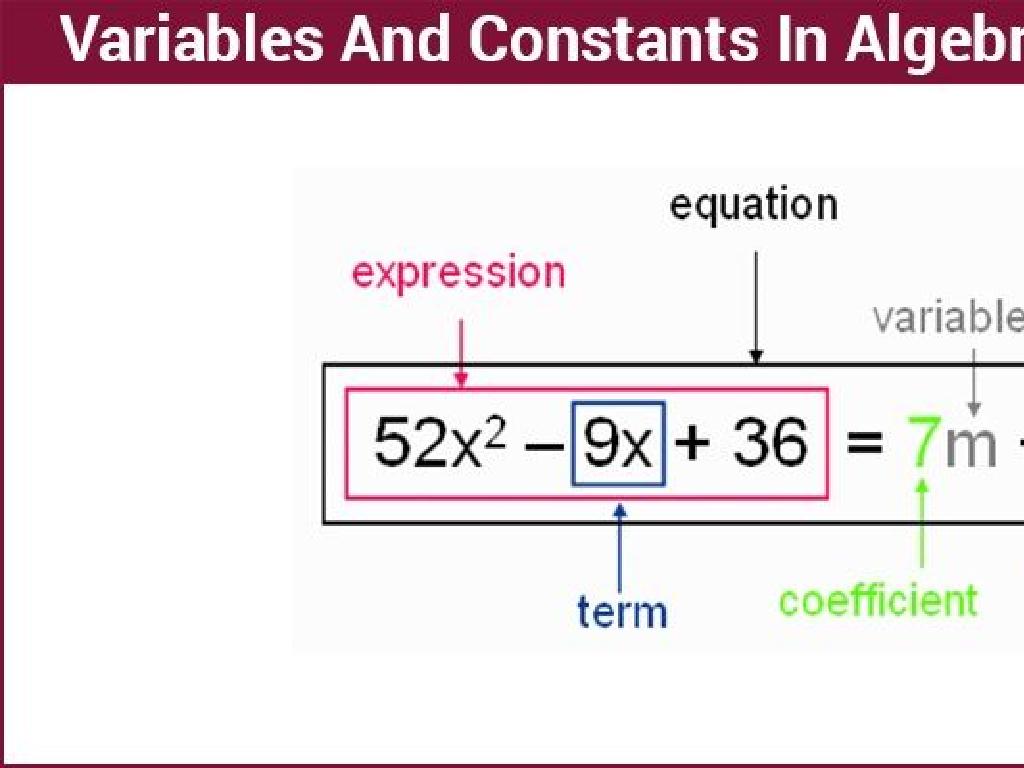Abbreviate Days Of The Week
Subject: Language arts
Grade: Third grade
Topic: Abbreviations
Please LOG IN to download the presentation. Access is available to registered users only.
View More Content
Abbreviating Days of the Week
– What are abbreviations?
– Shortened forms of words or phrases.
– Why use abbreviations?
– To save time and space in writing.
– Days of the week shortened
– Sun, Mon, Tue, Wed, Thu, Fri, Sat.
– Practice abbreviating days
|
This slide introduces the concept of abbreviations to third-grade students, explaining that they are shorter forms of words or phrases used to save time and space, especially when writing. Highlight the practicality of abbreviations in everyday life, such as when jotting down notes or marking calendars. Focus on the days of the week, providing the commonly accepted abbreviations for each day. Engage the class with practice exercises where they write the abbreviations themselves, reinforcing the lesson and ensuring they understand how to use each one correctly.
Abbreviating Days of the Week
– What’s an abbreviation?
– A shorter way to write words or phrases
– Examples: Dr., Jan.
– Dr. means Doctor, Jan. means January
– Abbreviations save time
– They make writing faster and save space
– Practice with days of the week
– Let’s abbreviate Mon., Tue., Wed., etc.
|
Begin the lesson by explaining what an abbreviation is, emphasizing that it’s a shorter way to write words, which makes writing quicker and saves space. Use familiar examples like ‘Dr.’ for Doctor and ‘Jan.’ for January to illustrate the concept. Then, transition to the specific topic of abbreviating days of the week. Encourage students to practice writing the abbreviations for each day, starting with Monday as ‘Mon.’, Tuesday as ‘Tue.’, and so on. This will help them become familiar with common abbreviations they will see in calendars and schedules. Make sure to provide guidance on the correct punctuation for abbreviations, such as the period at the end.
Abbreviating Days of the Week
– Seven days in every week
– Each day has a unique name
– Abbreviate days to shorten them
– For example, Monday becomes Mon.
– Practice writing abbreviations
– Let’s try abbreviating Tuesday together!
|
This slide introduces the concept of abbreviations, specifically focusing on the days of the week. Start by engaging the students with the fact that there are seven days in every week and each has its own special name. Explain that abbreviations are shorter forms of words used to save time and space, especially when writing. Show them how each day of the week can be abbreviated, such as ‘Sunday’ to ‘Sun.’ and ‘Monday’ to ‘Mon.’ Encourage the students to practice writing these abbreviations themselves, and prepare a worksheet with the full days of the week for them to convert into their abbreviated forms. This activity will help reinforce their understanding of abbreviations in a practical and interactive way.
Abbreviating Days of the Week
– Sunday to Sun.
– Monday to Mon.
– Tuesday to Tues.
– Wednesday to Wed.
– Thursday to Thurs.
– Friday to Fri.
– Saturday to Sat.
|
This slide is designed to teach third-grade students how to abbreviate the days of the week. Each day can be shortened to the first three letters, except for Thursday, which is abbreviated to ‘Thurs.’ It’s important to note that while abbreviating, the first letter is always capitalized, and a period is added at the end. Encourage students to practice writing these abbreviations and to use them when they’re writing in their journals or planning their week. This will help them become familiar with common abbreviations used in calendars and schedules.
Practice Time: Abbreviating Days!
– Let’s learn to abbreviate days
– Example: Thursday becomes Thu.
– Like how we shorten words to make them quicker to write
– Your turn to abbreviate
– Try abbreviating Monday, Tuesday, etc.
– Share your answers with the class
– We’ll review as a group and learn from each other
|
This slide is designed for an interactive class activity where students practice abbreviating the days of the week. Start by explaining that abbreviations are shorter forms of words we use to save time when writing. Show an example on the board or a piece of paper, such as abbreviating Thursday to ‘Thu.’. Then, ask the students to try abbreviating the days of the week on their own. They can write these down in their notebooks. After they have attempted this, invite them to share their answers with the class. This will allow for a group discussion and correction of any mistakes, reinforcing the learning process. Provide positive feedback and ensure that each student feels comfortable with abbreviating days by the end of the activity.
Using Abbreviations for Days of the Week
– Why abbreviate days?
– Saves time & space in writing
– Abbreviations in daily life
– Used in schedules, diaries, and communication
– Examples: Calendars & Planners
– Sun., Mon., Tue., Wed., Thu., Fri., Sat.
– Practice writing each day’s abbreviation
|
Abbreviations are shortened forms of words or phrases. Teaching students to abbreviate can help them take quicker notes and organize their schedules efficiently. It’s a skill that they will use in everyday life, especially when dealing with calendars, planners, and diaries. Show examples of each day abbreviated on actual calendar images if possible. Encourage students to practice writing the abbreviations themselves, reinforcing the concept that abbreviations are practical tools in written communication. This will prepare them for the next class activity where they will create their own weekly planner using abbreviations for days of the week.
Class Activity: Calendar Fun
– Receive your blank calendar
– Abbreviate days of the week
– Mon, Tue, Wed, Thu, Fri, Sat, Sun
– Decorate with colors and stickers
– Make it colorful, show your style!
– Share your calendar with the class
– Explain your work to your friends
|
This activity is designed to help students learn the abbreviations for the days of the week in a fun and interactive way. Hand out blank calendars to each student and instruct them to fill in the days with abbreviations: Mon, Tue, Wed, Thu, Fri, Sat, Sun. Encourage creativity by allowing them to decorate their calendars with colors and stickers. This will make the learning process enjoyable and memorable. Once completed, have each student present their calendar to the class, explaining the abbreviations they used. This will reinforce their learning and build presentation skills. Possible variations of the activity could include creating themed calendars or using the calendars to mark important dates such as holidays or birthdays.
Mastering Abbreviations for Days of the Week
– Congratulations on learning abbreviations!
– Incorporate abbreviations in your writing
– Instead of ‘Thursday’, write ‘Thurs.’ in sentences
– Use your calendar for daily practice
– Mark ‘Sun.’, ‘Mon.’, ‘Tues.’, etc., on your calendar
– Keep practicing and become an abbreviation pro!
|
This slide is a celebratory conclusion to the lesson on abbreviating days of the week. It’s designed to reinforce the students’ learning and encourage them to apply their new knowledge in practical ways. Remind them to start using these abbreviations when they write dates in their notebooks or when marking events on their calendars. Regular practice will help solidify their understanding. Praise their efforts and progress, and suggest that they keep a small calendar or diary as a fun way to continue practicing. You can also encourage them to quiz each other on the abbreviations to make the learning process interactive and enjoyable.






